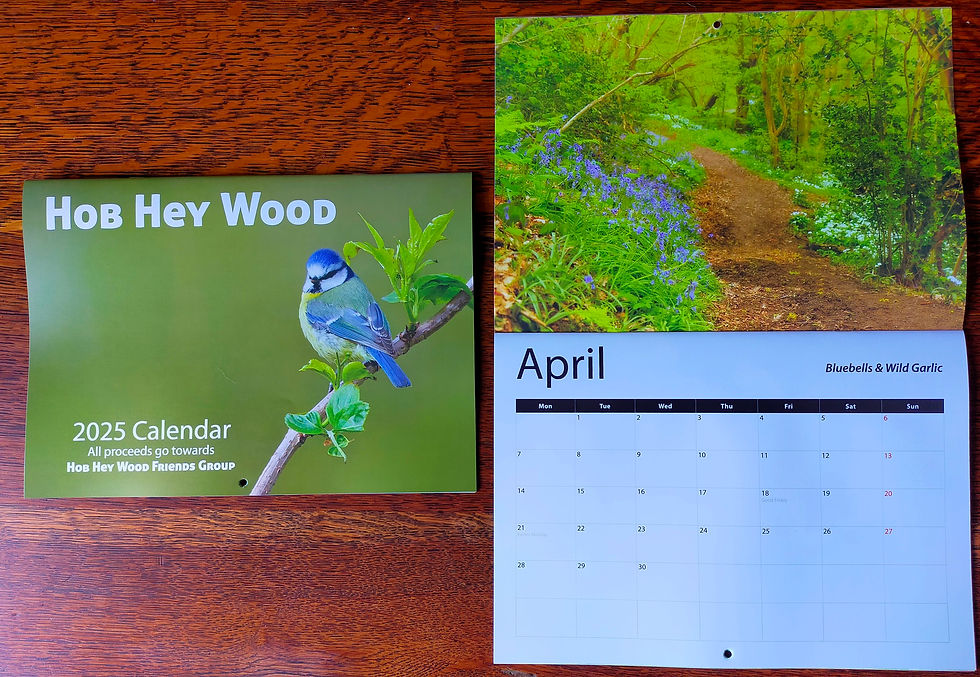Bats of Hob Hey Wood
- Mark O'Sullivan

- Sep 25, 2019
- 3 min read
Updated: Nov 26, 2019

Bats are ancient creatures, evolving into the only mammals that can fly over 50 million years ago and have spread to every continent except Antartica. They are quite common in Britain yet we know very little about them. There are 18 species of bat living in Britain but they’re so poorly studied that the pipistrelle was only separated into two species (soprano and common pipistrelles) as recently as 1970 and Nathusius’ pipistrelle only discovered to be living here in 1997!
Ancient semi-natural woodlands, with their profusion of aged trees containing many holes, nooks and crannies are extremely important to bats. Hob Hey Wood is no exception with many bats choosing to live here. They roost during the day so as you walk through the wood and see its old gnarled oaks and ashes, think about just how many bats may be safely asleep inside them. Hundreds? Probably.

I’ve been trying to discover just which species live in Hob Hey and bought a bat detector to help. As most people know, bats use ‘echolocation’ to find their prey in the dark. The sounds are too high pitched for humans to hear but bat detectors can detect them. The ‘Echo Meter Touch 2’ connects to a phone or tablet, records the bats’ calls graphically and converts the sound into sounds we can hear. As each bat species has different calls, the Echo Meter Touch 2 attempts to identify each bat detected.

I’ve visited the wood a couple of times recently and recorded seven species of bat: common, soprano and Nathusius’ pipistrelle; noctule; brown long-eared; Daubenton’s; and whiskered/Brandt's bat. As Nathusius' pipistrelle is quite rare in Britain, I decided to check that the meter had identified the bat correctly. I posted on the Bat Sounds Analysis Workshop Facebook page and experts confirmed that we do, indeed, have Nathusius' pipistrelle present in the wood! This is further evidence of the importance of Hob Hey Wood to Britain's dwindling wildlife. I wonder if there are any other species living in the wood?
Using the bat detector is quite exciting. You can sometimes see the bat, other times the calls show up on screen and the speaker blares out the high pitched calls, getting louder as the bat approaches then fades away. Then the meter identifies what you’ve heard. I’m starting to recognise the individual bat calls now and can pre-empt what the meter is going to identify.
My last session was quite busy with loads of bats in the air. The screen started to look quite cluttered with three, four, or even more bats calling at once! Although we can’t hear them, bat calls can be quite loud. As I was stood there in almost silence, I reflected that if we could hear bat calls, I would be almost deafened with the number of bats calling so close to me!
I was also treated to a fantastic sight. As I stood there, a moth flew past in the beam of my torch. Immediately a bat swooped past and took the moth, then disappeared. Amazing!
Of course, many of Britain’s bats are declining or under threat due to habitat loss and intensive farming. This is another reason why we should protect Hob Hey Wood, ensuring that it continues to provide homes and feeding places for these fascinating creatures.
Finally, here’s some incredible bat facts:
· A pipistrelle weighs about the same as a 2p piece and would fit into a matchbox with its wings folded.
· A pipistrelle can eat 3,000 insects in a single night.
· Bats sleep hanging from their feet, locking them in place so they don’t fall. They (fortunately) right themselves when they need a poo!
· One of the biggest cause of bat predation is domestic cats who can catch bats as they leave their roost.
· Male pipistrelles have been seen around streetlights, singing to females.
· Some moths evolved to hear bats’ echolocation calls to escape predation. The brown long-eared bat then evolved big ears so it could call softly and sneak up on the moths!
· Bats fly, not by flapping their wings, but by pulling themselves through the air, like a swimmer’s butterfly stroke.
· It is said that bats can get tangled in your hair. This is a myth. Bats are incredibly good fliers and would almost certainly never collide with a human!




Comments